




UNTIL 10 NOVEMBER 2024
WE’RE LOCKING PRICES ON KEY PRODUCTS FROM THESE CATEGORIES:
VIEW THE RANGE








UNTIL 10 NOVEMBER 2024
WE’RE LOCKING PRICES ON KEY PRODUCTS FROM THESE CATEGORIES:
VIEW THE RANGE



Tania Walters, PUBLISHER tania@reviewmags.com
Kiwis love their ice cream, and the industry is flourishing with growth across comfort and gourmet offerings. While new flavours occasionally make a splash, consumers consistently return to familiar favourites, finding comfort in wellloved classics.
This preference reflects a broader trend across the food and beverage sector, where nostalgic treats are driving sales as people seek affordable indulgences amidst rising living costs. Ice cream sales, in particular, highlight this trend, with many menus showcasing some old ice cream classics. However, alongside this desire for indulgence, there's a rising demand for healthier and more functional products.
New Zealand's ice cream

producers are adapting to these evolving tastes by launching plant-based, low-calorie, and sugar-free varieties, catering to health-conscious consumers. Artisan and small-batch makers are often at the forefront of these innovations, focusing on highquality, minimally processed ingredients. Their commitment to natural products, free from artificial additives, resonates with consumers increasingly wary of ultra-processed foods.
The industry, however, faces a delicate balancing act—offering indulgence while meeting healthdriven expectations. While some producers focus on plant-based gelato or high-protein options, many consumers still see ice cream as a purely indulgent treat. To address this, new products are embracing the concept
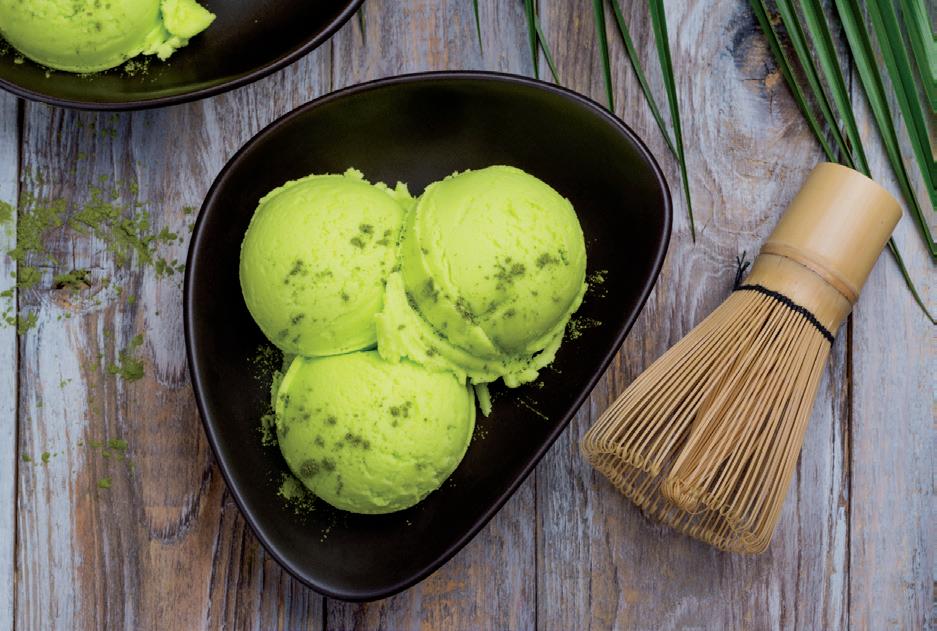
of 'permissible indulgence', combining indulgent flavours with better-for-you ingredients.
The growing popularity of functional foods also presents new opportunities. Younger consumers, in particular, are drawn to ice creams enriched with protein or energy-boosting components. Although niche, this segment is expected to grow as brands explore ways to innovate.
For New Zealand's ice cream producers, the challenge is to balance tradition with innovation, ensuring that whether consumers crave a vegan gelato or a scoop of classic vanilla, there is a flavour to entice everyone to eat ice cream.


































UKG has highlighted the reasons why New Zealand's retail workforce has lagged behind its global counterparts in AI adoption.
Despite the assumption that artificial intelligence (AI) and automation have infiltrated every sector of the workforce, new research commissioned by UKG finds that the New Zealand retail workforce is seriously lagging in AI adoption compared to Australian and Singaporean counterparts.
The survey of 213 Kiwi retail workers and managers found that only 33 percent were already using AI and automation in the workplace, compared to an overwhelming 92 percent in Singapore and 46 percent in Australia.
Read more online


The Newmarket Business Awards are back for 2024, dedicated to the local businesses that have contributed to the area's success over the past 12 months.
Newmarket has geared up to celebrate the best from across the area - with international retailers, bars, cafes, lawyers, fashion designers, beauticians, fitness centres and more among the finalists announced for the 2024 Newmarket Business Awards.
Read more online

Replaces
Stabilises
Internal
Enables
Independently
Exceeds
Install
Saves

In an era where artisanal, natural products are thriving, The Wild Fermentary stands out with its commitment to crafting small-batch fermented foods and beverages. Based in New Zealand, they specialise in nutrient-rich, hand-made ferments like sauerkraut, kimchi, kefir, and more.
Its fermentation process not only enhances flavour but also delivers a wealth of gut-friendly probiotics—perfect for modern restaurants that prioritise healthconscious, flavourful dining experiences. By partnering with The Wild Fermentary, chefs can add vibrant, tangy flavours to their dishes, elevating the menu with locally sourced, sustainable products.
Introducing Lime Cola: NZ’s First Ever Living Cola – Launching 1 November 2024
The Wild Fermentary is launching New Zealand’s first-ever living Cola, a limited
edition Lime Cola for Summer 2024/25.
Cola Kefir, a collaboration with Six Barrel Soda in Wellington, is a probiotic water kefir that combines the well-rounded, classic cola flavour with a burst of citrus notes. This unique creation merges The Wild Fermentary’s award-winning water kefir with Six Barrel Soda's beloved Cola syrup, enhanced with additional fresh, local lime juice.
Fermented naturally, Cola Kefir is alive with gut-loving bacteria that aid digestion and uplift the mind. Free from artificial flavours, colours, sweeteners, or preservatives, it’s all-natural and

low in sugar. Perfect on its own and ideal as a mixer in summer cocktails, it’s available in a convenient 300ml size.
Cola Kefir is the newest addition to the Kefir Soda range by The Wild Fermentary, which includes popular flavours such as Berry Blush, Ginger Root, Lemon Manuka, and Beet & Berry (the latter being a beverage winner at the Food Awards 2020).
The Lime Cola launch adds a fresh, tangy






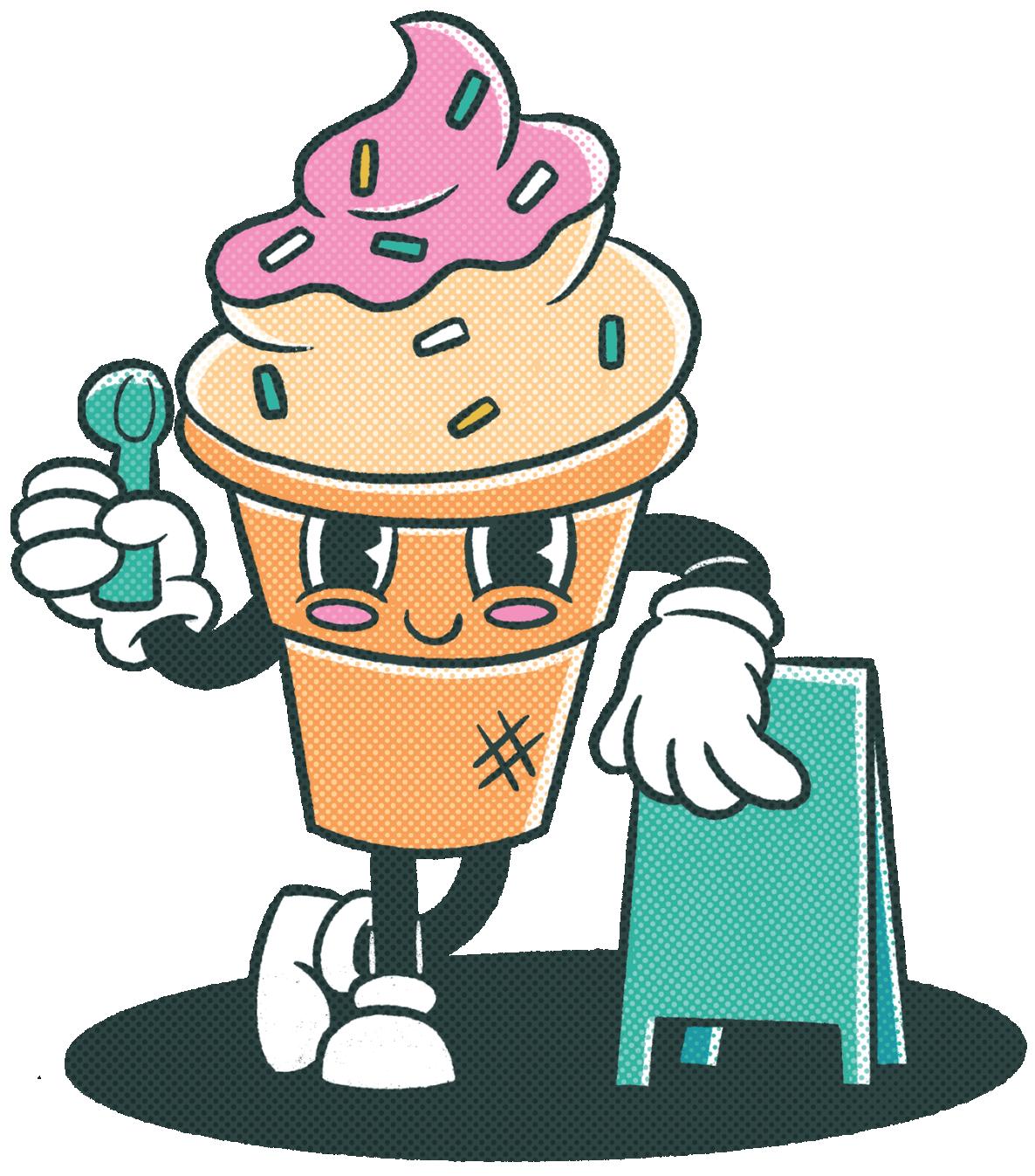
Ice cream, gelato and sorbet provide the taste of summer. From fruity flavours to rich and creamy combinations, there is something for everyone on the menu.
With warmer weather on the horizon, kiwis will be on the lookout for their new favourite flavour. Although business has been a struggle for many in the industry this year, there is a general sense of positivity in the air for a summer boom and an increase in foot traffic. Ice cream and other frozen desserts have been viewed as a way to attract customers, showcase innovation and an opportunity to sell a quality product.
For Pippa Scott, Director of The Gelato Lab, the world of frozen treats has continued to grow from strength to strength.
She said that international flavours have become highly popular with customers, as it can add to the overall customer experience.
"I'm not certain what's happening elsewhere, but we are always looking to increase our range of traditional Italian flavours (pistachio, crema, amarena) and new flavours and flavour combinations that New Zealanders might not have had previously," said Scott.
Scott added that an example of this was the slightly savoury basil gelato that The Gelato Lab has made for the last year, and its cardamom, apricot, and pistachio flavours that have increasingly been requested.
Although a wave of innovative flavours and
combinations has swept the local and international markets, customers have remained loyal to the flavours that they love. For The Gelato Lab, chocolate has remained its best-selling flavour. However, this was followed closely by Amarena (sour cherry) and Caramel—Peanut Brittle.
From a sustainability perspective, the ice cream business has very little wastage. While this is important to some customer demographics, it allows businesses to maximise profitability. Scott said it had been a particular focus of The Gelato Lab to buy ingredients from local producer, and where possible, minimise transportation and maximise flavour.
"For example, the hazelnut butter that we use is made by a producer in Rangiora who also grows the hazelnuts herself. Customers love the hazelnut gelato we make as well as the chocolate hazelnut ("bacio") gelato we make with it."
Offering diversity on the menu will allow customers to feel catered to. While some like soft and smooth flavours, others prefer their ice cream to be full of added ingredients like nuts, fruit or chocolate pieces; diversity in flavours will keep customers coming back for more.
Ice cream is attractive to customers of all ages and backgrounds and has proven itself year after year to be the top treat on every customer's list.


Whether it's the flavour of the month or a signature scoop from days past, every ice cream parlour has a distinct approach to offering fresh and new flavours, as well as traditional varieties that have never gone out of style.
For Auckland-based Giapo, Kiwi customers have never parted with the classics. "The flavour that holds a special place in our hearts and is consistently requested is Hokey Pokey—a Kiwi classic steeped in nostalgia and cultural significance," said Annarosa Petrucci of Giapo.
Petrucci said this was often the case when grandparents brought their grandchildren for a treat and also when tourists ask "what is Hokey Pokey?"
"For us, it's more than just a flavour; it's a taste of New Zealand's history, and it's our most loved. While we honour tradition, even with Hokey Pokey, we innovate through texture and presentation."
For some businesses, it has been their mission to serve unique flavours or combinations not
usually found anywhere else. For Black Peak Gelato Wanaka, this has been a significant asset to their standing in the community, with flavours such as Rum and Raisin, Apple Pie, Licorice ice creams, as well as Coca-Cola gelato and Feijoa sorbet.
Manager Maddy Doran said that global trends have always been a key insight as to what customers expect and keep them returning to the store.
"A very trendy flavour at the moment is Lotus Biscoff. As soon as we made it for the first time, we sold it out straight away," she said.
Doran added that the store still has a demand for the classics, with flavours like seasalted caramel and cookies and cream that had been forever popular.

Juan Balsani of Pistackio in Mount Eden said there was a distinct shift towards more fresh, vibrant and natural flavours. One noticeable trend has been the introduction of 'free-from' gelato.
"This means free from pre-made gelato bases and other derivatives, free from added sugars, free from additives, and free from emulsifiers. Also, there is an increase in complementary flavours added to the gelato, most of which are made in-house and make all the difference. Is looking very promising for the gelato lovers," said Balsani.
He added that consistency matters most to customers, as opposed to the latest flavour of the month.
"We'll keep doing what we do, serving great gelato, friendly customer service and inviting

ambience. This consistency is what matters the most to our community, and this has been setting us apart so far, so we'll carry on not trying to reinvent the wheel."
The same can be said for Karl Tiefenbacher from Kaffee Eis, who predicted a steady summer ahead and focused on delivering an exceptional product with the service to match.
Tiefenbacher believed that although there was a range of over 45 gelato flavours on the menu to cater to all customers, such as water-based, dairy-free, vegan and gluten-free options, the classic flavours outsold everything else, particularly chocolate and caramel.
Aside from this, Tiefenbacher said there has been a wave of innovation in the local market, with companies attempting to differentiate their offerings. He said that exotic fruit and savoury flavours have become more prominent.
The trend for savoury options has offered customers a point of difference, with some local producers making global headlines because of their weird and wonderful flavours. An example of this was Auckland parlour Fugitoto Ice Cream, which introduced a salmon flavour to its menu.
"We were delighted that customer reactions to our Salmon Ice Cream have been overwhelmingly positive. Our unique sales approach, featuring a "secret box" that exclusively has offered a taste of New Zealand King Salmon paired with wasabi, has garnered enthusiastic responses," said founder Jenny Yuchi.
Yuchi added that customers expressed genuine surprise to find the flavour on the menu, and had described it as unprecedented and delightful.
"The rich creaminess and the infusion of homemade wasabi has elevated the salmon's taste and ensured there was no discernible fishiness."
Fugitoto Ice Cream has made
innovation a key influence to its offerings, with plans for other unique flavour combinations in the pipeline. It has also been a way to secure customer traffic and manage demand for other flavours.
"Our salmon ice cream signified a pioneering step in New Zealand's culinary landscape and attracted a consistent flow of customers on a daily basis. To maintain the product's freshness, we implemented a strategic approach, limiting midweek supplies to one tray and weekend supplies to two trays."
As summer approaches, many New Zealand ice cream businesses are focused on global trends, new and exotic flavour pairings, but most of all ensuring there is demand from customers during the current economic turbulence.

With summer rapidly approaching, ice cream vendors can expect to be flat out during the busy season. However, with economic turbulence and the cost-of-living crisis lingering, customers have become increasingly cautious with their disposable income.
The cost of ice cream has become a major factor for customers to consider, especially with a move towards fresher, vibrant and natural flavours. Offering customers a substantial scoop for a reasonable price has been a difficult task to balance, especially in a highly competitive market.
With the ongoing cost of living crisis, price sensitivity has increased among customers.
Peita Kensignton from Little Liberty Creamery said that while customers were still aware of the value of sustainable and allergen-free products, more people have been cautious with their spending.
Plant-based options, which often cost more than traditional dairy products, can be seen as a premium purchase. However, many customers recognise that they are paying not just for the product, but for the quality, sustainability, and freedom from allergens like dairy, gluten, and soy.
Despite the economic challenges, there’s still a willingness to invest in treats that align with customer’s values and dietary needs, but business owners are mindful of keeping products as accessible as possible.
For Auckland-based Giapo, pricing is transparent. The company has understood that it has some of the highest-priced ice creams globally, but it has reflected the craftsmanship and premium ingredients used. Customers have appreciated the detail and care put into Giapo creations, as well as a low-priced entrylevel cup so it’s accessible for everyone.
Karl Tiefenbacher of Kaffee Eis in Wellington said there is now an acceptance among customers that premium products will come at a premium price, with single scoops sitting anywhere between $6.50 to $8.50 around the country.
“With the general increase in price for just about everything you buy these days, people seem to be accepting of this. Getting that price-to-value ratio right will continue to be the most important decision for the longevity of businesses,” said Tiefenbacher.
Ice cream brands are now under pressure

to produce sustainable products that align with customer preferences. Sustainability has continued to be a highly competitive edge for small ice cream and gelato businesses around the country.
Although this has meant that many companies have had to reevaluate their production process, for many it has offered an opportunity to work with other local suppliers and to use higher quality ingredients.
For Little Liberty Creamery, sustainability is at the core of the entire business. Having recently partnered with local company Huhtamaki, Little Liberty has produced homecompostable packaging to ensure it is aligned with its overall mission to reduce environmental impact. This has also extended beyond its packaging, with influence on ingredients as well.
“We aim to create flavours that are both delicious and responsibly sourced, making sure that every part of our business is ecoconscious,” said Kensington.
Giapo has incorporated organic ingredients in its ice creams, with additional priorities to tackle food waste and carefully select its packaging options to minimise environmental impact.
Beyond that, sustainability has also meant creating an experience that will last for its customers, which Giapo’s Annarosa Petrucci said included unforgettable moments and timeless stories around ice cream.
“We are always evaluating how to improve our sourcing and reduce our footprint, but it’s balanced with the quality and craftsmanship we demand,” she said.
Juan Balsani from Pistackio Gelato in Auckland said it was very important to be connected with the ingredients used in the cooking process.
“To produce great tasting food, the understanding of the product and simple techniques are our only focus at Pistackio. From organic milk to great products such as heilala vanilla, I put my fine dining chef experience in reflecting this care for the products in every scoop,” said Balsani.
Despite challenging factors, there is still strong demand for ice cream, with added support for sustainably produced flavours. As businesses balance affordability with sustainability, many have innovated to reduce costs but maintain quality.
The perfect summer addition to your business.
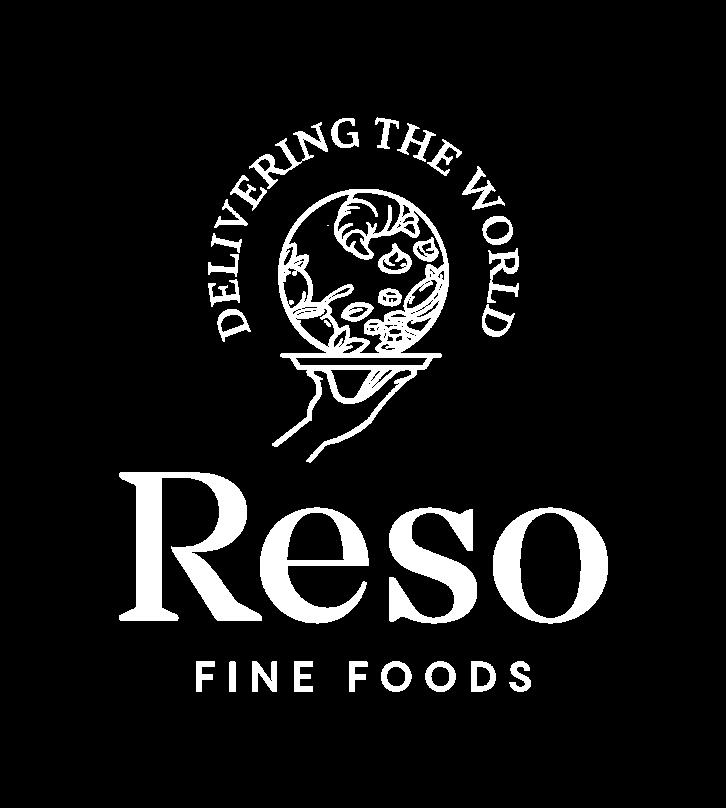

With summer rapidly approaching, ice cream vendors can expect to be flat out during the busy season. However, with economic turbulence and the cost-ofliving crisis lingering, customers have become increasingly cautious with their disposable income.

Just like coffee, smoothies are an everyday choice for customers. Global trends have influenced consumer demands, and the use of natural ingredients has appealed to health-focused customers.
In the modern hospitality landscape, smoothies have adapted into a range of products found on the menu. One notable example has been the rise of Acai bowls.
For cafe chain Bowl and Arrow, Acai bowls have come back on trend, more so than last year. Co-owner Leisha Rae said more people have discovered Acai bowls, and there are more available on the market than ever before.
“I think this has a lot to do with influence from Australia and the US, where Acai is hugely popular. People are travelling more and trying Acai overseas and then looking for it back here in New Zealand,” said Rae.
The use of frozen fruits and vegetables on Bowl and Arrow’s menu have spread across its smoothie and Acai offerings.
Rae said this has worked out to be highly sustainable, especially for fruits not in season, and it has resulted in a zero-waste method. She said everything could be kept contained and nothing had to be thrown out at the end of the day or week.
As for juices, in-season fruits and vegetables are the most popular with customers, however Rae said due to the cost of out-of-season produce, these are rotated through summer and winter.
As price point has been a main concern for customers and business owners, Rae said it can be difficult to keep up with customer expectations.
“It can be really tricky when the minimum wage is increasing all the time, and our ingredient and packaging costs have in some cases, doubled or tripled. The general mindset is that smoothies and smoothie bowls should be the price of a drink, but ours are a full-sized meal and contain really premium ingredients. So it's about educating people that actually, for a meal, NZD $18 (for a smoothie bowl) is really reasonable.”
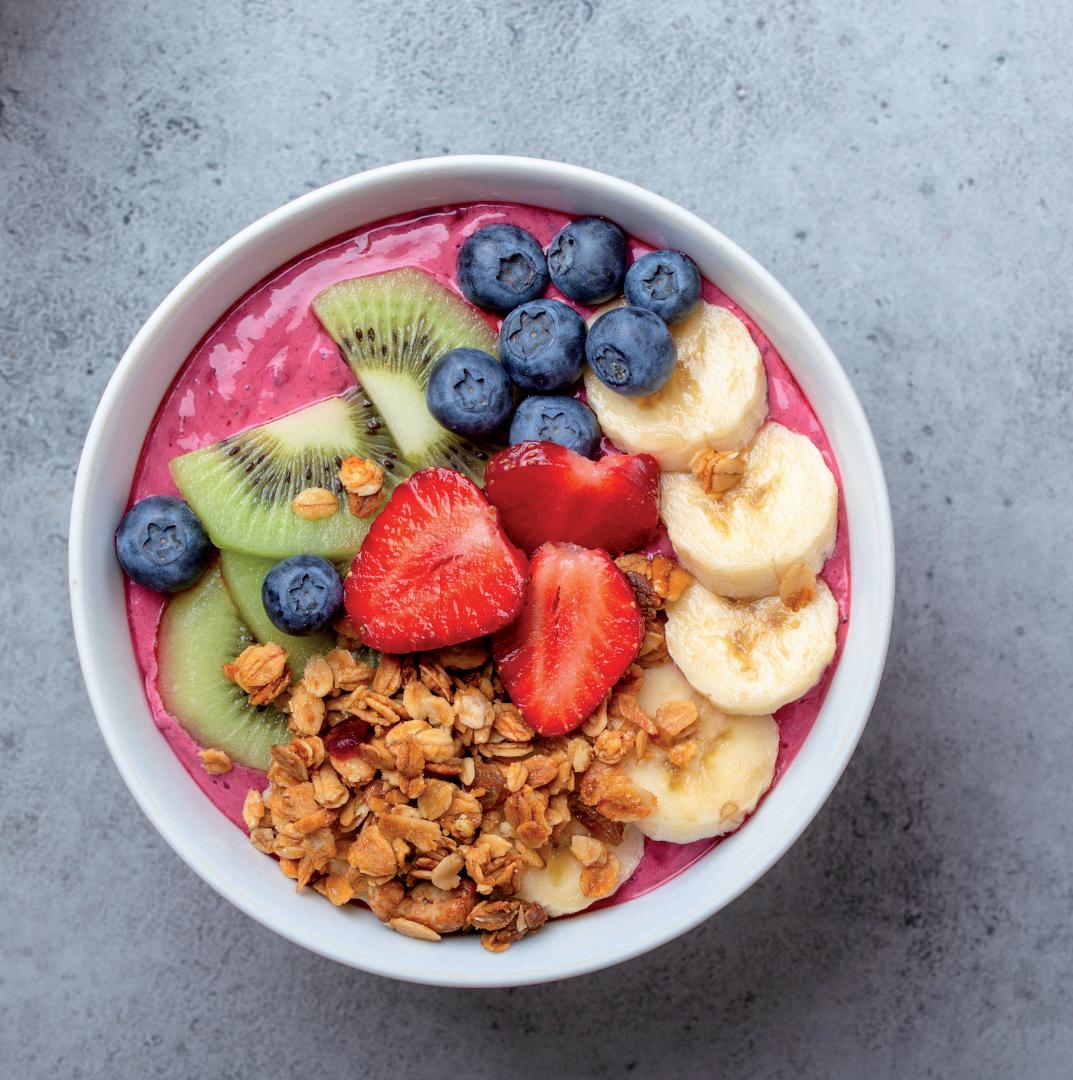
Among customers, fruit smoothies have remained the most popular flavour of choice, with flavours such as strawberry, mango and banana leading the trend.
Spinach and kale have also become a major drawcard for customers, especially those driven by health benefits. Vegetable-based drinks, supplemented with various spices and herbs, have gained popularity as part of the wellness movement.
Nutrition-based smoothies have become
convenient for customers in search for an onthe-go beverage, especially containing proteins, calcium and even some vitamins. Smoothies are also a low-fat and gluten-free option, appealing to almost all customers.
Although ingredients are important to some customers, many value flavour as an essential requirement. The choice of smoothie base has become more specific to every customer, and something businesses have now introduced as a customisable service. While sweetened and natural yoghurt has been a staple base for smoothies, other options like coconut water or milk alternatives such as almond or soy have joined the menu.
Pre-blended smoothie bases are another way for businesses to offer a fast, efficient and reliable product to customers, with minimal prep and without mess. This will ensure taste and value, and can serve as a canvas for added ingredients, such as fruits and vegetables, sauces or spices.
Rae said that the cost-of-living crisis has influenced the niceties that customers are able to afford on a regular basis, and that with high-quality ingredients, it was vital to make smoothies as accessible as coffee or tea.
“We have recently changed our menu to include half-sized bowls as an option for a snack or for kids, and these have been really popular. I think customers just need a cheaper option available so they are still able to purchase something, but not necessarily spend what they used to. We also have a loyalty club system where customers accrue points whenever they spend, and this is a great way to encourage repeat purchases as well as letting them save some money.’

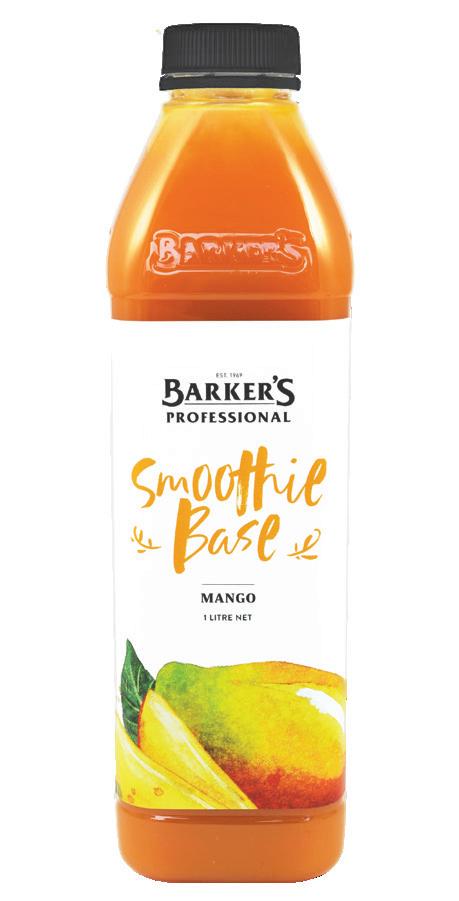





Loved by all ages, milkshakes and thickshakes offer variety on the menu and flavours that customers love.
With a touch of nostalgia, shakes offer cafes an opportunity to be creative with flavours and embellishments, as well as presentation and service.
Refreshing and portable, milkshakes are a convenient solution to satisfy busy customer cravings on the go. Despite typically being seen as a desert, customers are more likely to order milkshakes as a snack throughout the day. This has also supported demand for other sweet treats, such as pastries and muffins.
Shakes are found in all hospitality areas, from up-market cafes to quick-service restaurant menus. They are a universally essential item
that customers will expect to find on the menu.
Like other cafe beverages, shakes have adapted to the growing trend of milk alternatives. The rise of dairy-free beverages has been influenced by varieties such as coconut milk, almond milk, and soy milk, which has also made them more attractive to a larger customer base.
For Ron Lal of Black Antler Eatery, the most popular flavours have been Ferrero and Biscoff. He said Kiwi customers eventually caught on to the global trend of Biscoff flavours but were initially hesitant as it was still relatively new in the local market.
Wellington eatery Sweet Mother’s Kitchen has won customers with its Snickers milkshake. With rich chocolate, peanuts, caramel sauce and a nougat centre, customers can satisfy their sweet tooth and curb their hunger. This has also tapped into the growing demand for luxury flavours, like salted caramel or hazelnut praline.
Cookie flavour trends have also found a prized place among customer preferences.
Hamilton cafe Copper and Cream said Oreo was one of its most popular flavours, along with chocolate and coffee.
Coffee-infused flavours have offered customers a more sophisticated flavour, like mocha or cappuccino, and a broader outreach for businesses. Cafes have also begun using in-house roasted coffee, cold brews, and other premium coffee flavours to offer a daily caffeine fix.
Customers have shifted their tastebuds to natural flavours, all of which have been popular milkshake choices. From fruit purees to distinct spices to give an extra bite of flavour, much of the market has now been dedicated to supplying natural flavours that customers love.
Natural flavours may also be found in the ice cream or milk used to make shakes, reducing hassle for baristas and ensuring a balanced taste for customers.
As the retro-diner trend has continued, milkshakes and thickshakes have mainly been part of its success. This has highlighted traditional flavours, such as chocolate,
From towered stacks of doughnuts and sprinkles to caramelised popcorn and candy floss, there is no limit to how creative baristas can be when crafting this signature drink.
strawberry or vanilla, served with a signature swirl of whipped cream and glace cherry.
Fiona McLeod of Auckland’s Broadway
Diner said it has found success with oldfashioned milkshake flavours, made with full cream milk and New Zealand vanilla ice cream. She said the most popular flavour was chocolate, which has accounted for about 40 percent of sales. Other popular flavours have included vanilla, caramel, and creaming soda.
Glassware has also been part of the trend’s resurgence to modern hospitality settings. Tall, old-fashioned glasses with a curved base and rippled sides have offered customers a look reminiscent of the 1950s.
For a rustic approach, many cafes now serve milkshakes directly from the canister. While this has communicated to customers that their drink is fresh, ensuring sufficient volume has proved crucial. Rustic flavours have also gained attention, from savoury selections like peanut butter to sweet and salty combinations.
One of the most popular global trends for businesses has been overloaded milkshakes, commonly known as ‘freak shakes’. Adorned with latherings of syrups, ice cream, and toppings, freak shakes offer customers a unique
dining experience with a personalised touch.
Made mainly with items already stocked, freak shakes are a profitable menu item to consider, as guests are willing to pay for the experience and the product. From towered stacks of doughnuts and sprinkles to caramelised popcorn and candy floss, there is no limit to how creative baristas can be when crafting this signature drink.
Looking ahead, Copper and Cream have adopted the growing trend of Irish Cream and Mango milkshakes, two flavours that it said were on the rise. There has also been significant demand for frappes with wide flavour versatility.
To appeal to an older customer base, Sweet Mother’s Kitchen has also discovered the success of Boozy Shakes, which it said has stolen the show. Its signature blend, Foxxy Love, mixes Kahlua, espresso, and chocolate. This has tapped into the growing international trend of alcoholic shakes inspired by flavours like orange liqueur, pineapple rum, and bourbon.
Shakes have consistently adapted to trends and customer demand, and ahead of the warmer months, will continue to be one of the most ordered items on the menu.

Since 1968, the iconic blue and red giraffe image has appeared on the side of the cups used by dairies, ice cream parlours, cafes and takeaways for milkshakes and thickshakes. Nearly every Kiwi will have had a shake in one of these cups and the sight of one will bring back memories of walking home from the local pool on a hot summer’s day, Friday fish and chips wrapped in paper or holidaying at the beach with family. Each memory triggered by the thought of slurping down a cold shake.
Today The Longest Drink In Town remains New Zealand’s favourite milkshake and Kiwis of all ages still love popping down to the local shop and getting a cold shake with their own favourite flavour. These flavours have been made for the last ten years by Delmaine Fine Foods, one of New Zealand’s leading food manufacturers, through high quality milkshake syrups under the Longest Drink in Town brand.
This summer make sure you take advantage of the country’s love for milkshakes and the brand that brings back so many memories, by having a good supply of The Longest Drink In Town cups and syrups.
To find your nearest stockist contact Delmaine Fine Foods on 0800 335 624 or speak with your local representative.







The variety of ice machines available to restaurant and bar owners can prove to be an invaluable asset; however, contributing factors can determine their suitability and longevity.
nsuring that an ice machine is maintained correctly will require time and effort. Machines also need to be cleaned on a regular basis and align with regulations. Any failure to do so can result in deterioration of the machine’s production, a shorter lifespan for the machine, and it can become an inconvenience.
Repairing an ice machine can be an expensive exercise, which highlights the need for business owners to have a backup plan in place in case of any unexpected problems.
Although ice may seem to be a simple concept, ice machines are complicated pieces of equipment. Installing an ice machine will require the assistance of a professional. Machines can be damaged and productivity can be reduced due to poor installation. Professional help will also benefit business owners for warranty purposes as well.
Ice machines provide convenience for bars and restaurants, as they save time and can be
highly efficient. An in-house ice machine will always ensure there is a sufficient supply of ice, which can be served immediately to customers or bagged and stored away.
Chilled drinks are always in popular demand, particularly ahead of summer. An ice machine on hand will be invaluable for cocktails, soft drinks, milkshakes, and smoothies. Professional ice machines can also produce different styles of ice to impress customers, such as flaked ice, shaped ice, and shaved ice.
This can enhance the customer experience, especially in establishments where presentation is a vital part of the service. Serving drinks with unique ice shapes or textures can set a business apart from the competition and create a memorable impression with customers. Customers want to know that their health and safety is a priority at every stage of service. For this, ensure the right equipment is used to transport ice from the machine to the bar. Although an obvious solution, a stainless steel
ice bucket will not only have an effective look but is a cleaner option as opposed to plastic.
Health and safety are not just a priority, but a responsibility when it comes to handling ice. For hygiene reasons, ice should always be served with clean utensils. Ice scoops and tongs not only create a luxurious impression for guests but also prevent contamination, as well as enhance the establishment’s reputation.
Ice machines are capable of producing large amounts of ice quickly and efficiently, ensuring that a consistent supply is always available to meet customer demand. Whether ice is needed for cocktails, soft drinks, smoothies, or milkshakes, an in-house ice machine will eliminate the need to purchase ice from outside sources, which will save time and money.
Ice machines are an asset for restaurants and bars and provide an essential service. Through different functions and suitable maintenance, ice machines can significantly impact the success of service and business.

SilverChef Certified Used Equipment is warranty backed, after undergoing our 5-stage refurbishment process.

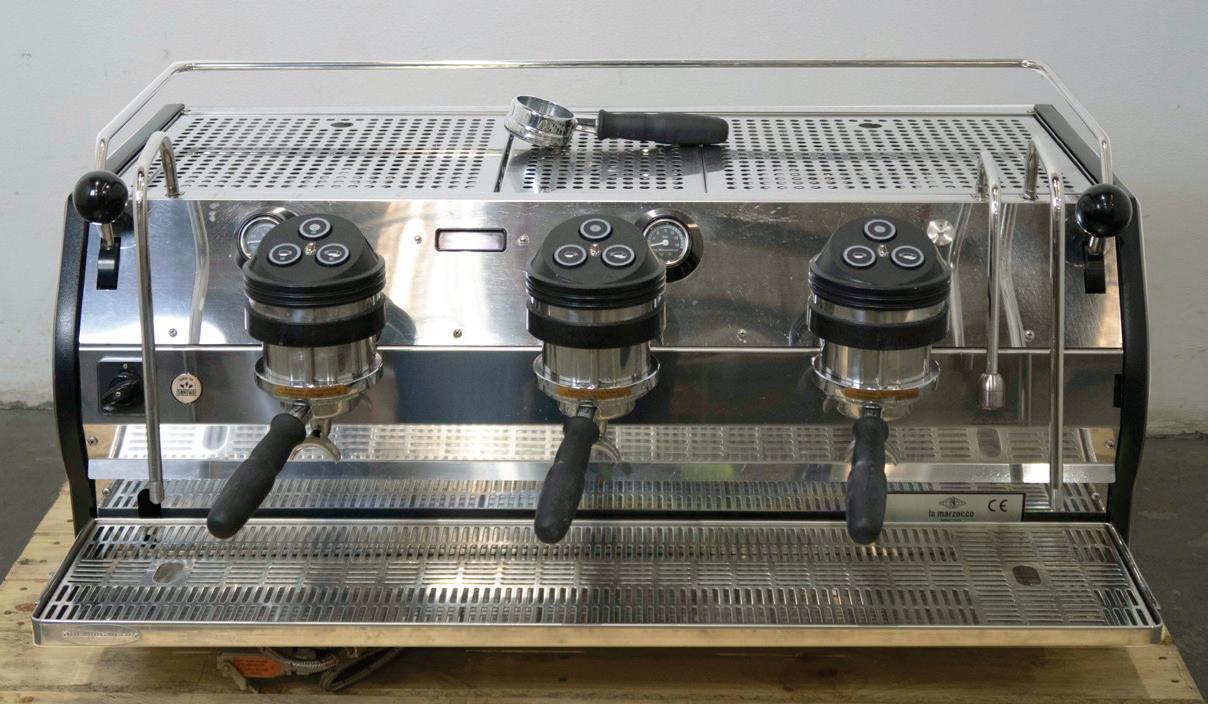
Pay with Rent-Try-Buy for low weekly payments that are 100% tax deductible, or purchase outright.
It is not uncommon for ice to be an essential component of a cocktail, be it cubed, crushed, shaved or speared.

In many cases, mixers, spirits, and garnishes tend to take preference over ice when improving the taste of a beverage.
For bartenders, the quality of ice used can either enhance or diminish the beverage's flavour, creating the demand for premium ice.
While quality ingredients measured to the right proportions, garnished perfectly and served in style may create an effective look for customers, the incorrect amount of ice can turn an impressively mastered beverage upside down.
Ice is more than a way to chill a beverage. When melted, it becomes an ingredient, a solution for frozen drinks, and an effective tool for a showstopping effect.
Scott O'Connor from The Churchill in Auckland said that ice was vital for mixologists, but in some cases, a lack of ice was just as important.
For O'Connor, ice can have a huge effect on the flavour and presentation of a drink.
"It's all about dilution and flavours that change with that on top of the temperature, of course," he said.
As with flavours and presentation, trends can influence how ice is served, whether it's a chic and classic approach or a show-stopping avantgarde display to impress customers.
For example, humble cocktails like a gin and tonic served with standard, cloudy ice cubes may have all the flavour profiles to taste good but lack the visual impact that is important in the modern market. Alternatively, the exact same
cocktail made with large, clear ice cubes or an impressive ice ball will immediately look more enticing and be made to a higher standard. Clear ice will enhance the drink's appearance and make it look as refreshing as it tastes, elevating the customer's overall experience.
An understanding of the difference that premium ice can have will not only enhance the menu, but demonstrate professionalism and a higher standard of service to customers.
Purity and melting rate are two of the most essential factors for bartenders to consider when crafting their next concoction.
Premium ice made from filtered water will remove any impurities and minerals, ensuring that all ice is clear and removing any unwanted tastes to preserve the flavour of the drink. The slow freezing process used to make premium ice will eliminate any air bubbles, minimise cloudy textures and produce a solid block of ice that won't melt as soon as it's added.
Premium ice will ensure that a customer's last sip is as good as the first, as it hasn't been diluted and has kept its balance of ingredients.
For restaurants and bars with a high-end appeal, premium ice can become part of its brand identity. The use of premium ice will echo the theme of quality and encourage customers to return when consistently served with a high standard of service. Alternatively, it is important for the right balance of ice to be added, which will avoid any complaints from customers that their glass has been filled with
ice to save on costs and ccheapen outon the volume of other ingredients.
Not every beverage requires the same variety of ice, which can make signature cocktails appealing to customers and charge a higher price.
Crushed or shaved ice can be perfect for some cocktails that benefit from a bit of dilution. It will also enhance the beverage through texture and taste and provide a necessary quick chill when served.
Spherical ice is not only functional but visually compelling for customers. A common sight in high-end establishments, spherical ice will minimise surface area due to its shape and melts at a slower speed than regular cubes.


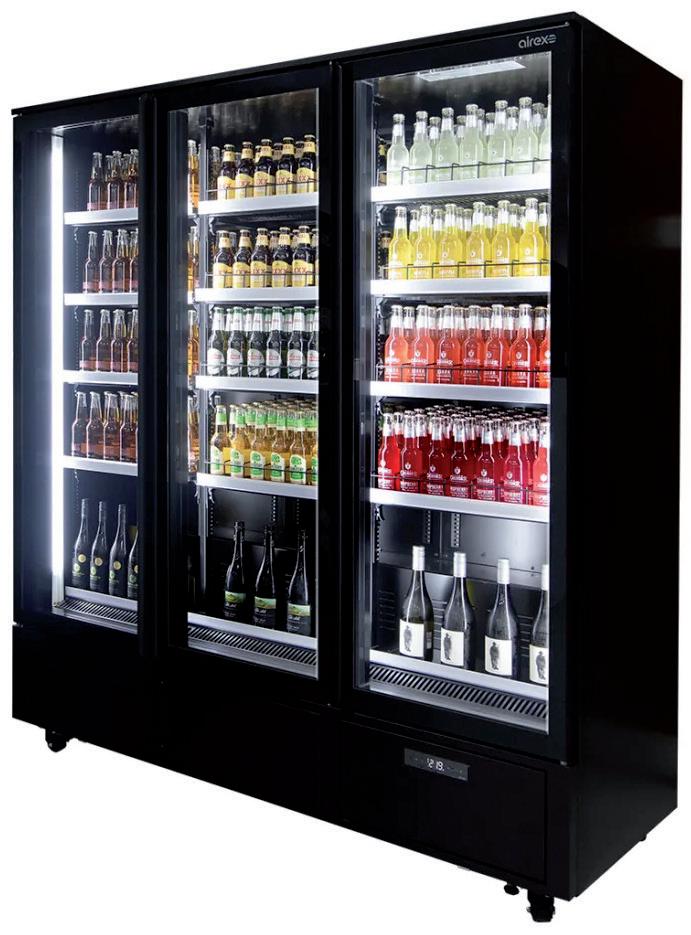
Display your products in style with Airex’s sleek, energy-efficient merchandisers and refrigerated back bars.
In today’s competitive market, the way you present your products can make all the difference. Airex has reimagined the art of merchandising with its newlook Merchandisers and Refrigerated Back Bars, designed to showcase your offerings in a sleek, efficient, and eco-friendly way. Here’s why Airex should be your go-to choice for maximising sales.
Presentation is key, and Airex Merchandisers deliver just that. Available in Single, Double, and Triple Door options, these upright units are perfect for cold drinks and food, providing an irresistible, ready-to-serve display in any front-of-house setting. Their sleek design ensures that your products are always the star of the show.
Whether you’re working with the AXR. MEUR.1D, AXR.MEUR.2D, or AXR. MEUR.3D series, Airex Merchandisers are built for one thing: exceptional visibility. With frameless, ultra-clear, Low-E double glazed Argon-filled glass doors, energy-efficient LED lighting, and adjustable temperature controls,
these merchandisers ensure that your products look their best, while keeping condensation at bay. Customers can’t help but be drawn to the brilliant display!
Sustainability is at the forefront of Airex designs. Each merchandiser is equipped with eco-conscious R290 Hydrocarbon refrigerant and cyclopentane polyurethane insulation, reducing energy consumption while maintaining optimal cooling. Not only do you get a high-performance unit, but you also contribute to a greener planet.
Maintaining a clean, professional display has never been easier. Airex Merchandisers feature a smudge-free electrostatic finish, which resists fingerprints and marks. This means your display stays spotless, keeping your brand image sharp and always appealing.
Airex Merchandisers are designed with the user in mind. With adjustable shelves, selfclosing doors, castor wheels, and adjustable leveling feet, these units provide flexibility for various setups. The standard product guides and ticket stripping make organizing your display a breeze. For businesses with space constraints, the Slimline and Countertop units offer compact solutions without sacrificing display quality.
and Space-Saving Airex Refrigerated Back Bars
For bars and restaurants, the Airex Refrigerated Back Bars provide the perfect balance of style, function, and efficiency. Available in 2-door and 3-door configurations, these units feature rear-mounted refrigeration to save space, while the double-glazed heated glass doors and energy-efficient vertical LED lighting enhance product visibility and reduce condensation.
With an adjustable digital temperature controller and fan-forced airflow, you can ensure that your drinks are always kept at the ideal temperature. The modern black internal finish (excluding the base) adds a sleek aesthetic, creating a sophisticated back bar that enhances the overall ambiance of your establishment.
From Merchandisers to Refrigerated Back Bars, Airex delivers stylish, energy-efficient, and environmentally friendly solutions that elevate your product displays and drive sales. With features that prioritise ease of use, sleek presentation, and energy conservation, Airex ensures that your business stands out in every possible way.
Make the switch to Airex today and watch your products shine like never before!
For more information visit www.stoddart.co.nz


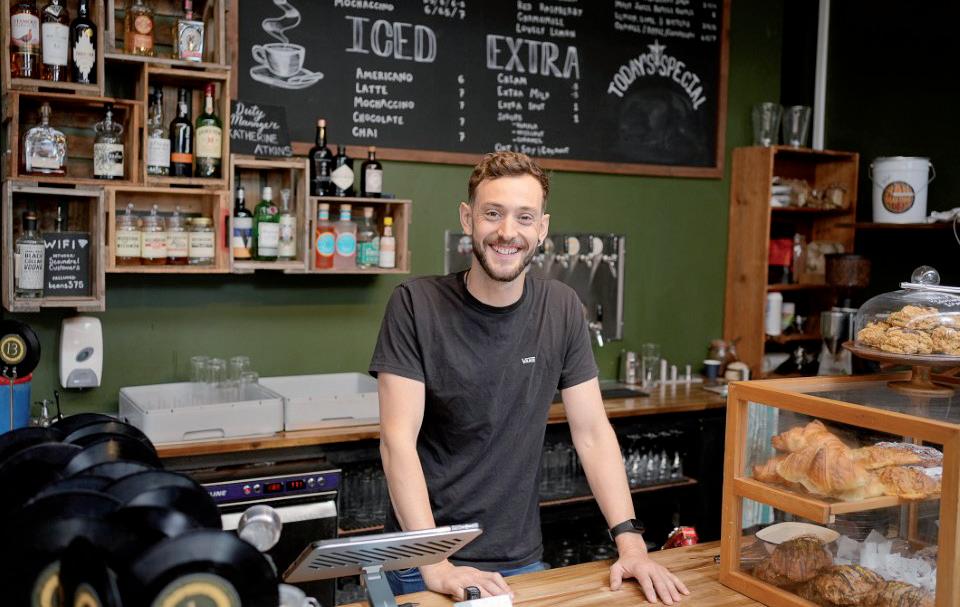
Running a hospitality business is challenging and requires creativity, agility, and passion. As living costs continue to rise in FY25, many owners are questioning their business's future. However, by adopting cost-effective strategies and focusing on sustainability, hospitality owners can build a more resilient foundation for long-term success.
Embrace sustainability
Environmental sustainability is no longer considered an ‘eco-trend’ but has cemented itself as a crucial factor in the success of any business success, regardless of size.
As a hospitality business, taking stock (literally) of the level of food waste, and actioning better ways to manage it, will not only have a positive environmental impact but long-term improvements on the streamlined efficiency of the business.
Ways to reduce waste and integrate sustainability into your business:
• Conduct a waste audit: Track what’s wasted and why. Understanding the main sources of waste in your kitchen can help implement targeted reductions.
• Stay seasonal: By aligning your menu with seasonal ingredients, you can reduce costs,
ensure freshness and keep your customers excited with new offerings.
• Lean on Government resources: Across New Zealand there are multiple resources and guides created to support businesses and communities in limiting their food waste impact. A great place to start is this extensive guide from the Ministry for the Environment. Take advantage of these resources to create a sustainable action plan, tailored to your business.
Check in on your cash flow
Maintaining healthy cash flow is vital for the survival and growth of any café or restaurant. It ensures that the business can cover its dayto-day expenses, like wages, inventory, and rent, while also being prepared for unexpected costs such as equipment repairs or fluctuations in demand. Rising costs make it essential for businesses
to explore creative ways to manage their finances and stay prepared for unforeseen expenses.
• Rent equipment instead of buying: Opting for rental agreements, such as SilverChef’s Rent-Try-Buy, can save you from large upfront costs. This approach offers flexibility with low weekly payments and the ability to change or upgrade equipment, so you can pivot your kitchen or menu, in line with customer demand.
• Monitor financial health weekly: Track cash flow closely, adjusting for any changes. When it comes to your business finances, ignorance is not key! Additionally, understanding the end-of-term details of any supplier contracts means you’ll have more chance to shop around or leverage better deals.
• Implement Dynamic Pricing: Consider adjusting your pricing based on demand. For instance, offer happy hour discounts during slower periods or create premium pricing for peak times. This approach can help optimize revenue throughout the day and keep customer traffic steady. Regularly review your menu prices to ensure they reflect
current ingredient costs and stay competitive in the market.
Snap-happy customers act as brand ambassadors, sharing their experiences with their followers, increasing your visibility without any additional marketing costs.
Social media posts, especially visually appealing ones, can build buzz around your venue, showcase the atmosphere, and highlight your food and drinks. This usergenerated content often feels more authentic to potential customers, boosting your reputation organically. Encouraging this behaviour can also foster a sense of community and create a loyal customer base that feels connected to your brand.
Here's some ways to make the most of this trend:
• Create photo-worthy spaces: Enhance your venue’s visual appeal with unique decor or beautifully presented dishes that customers will want to capture and share.
• Encourage user-generated content: Run a social media contest or create a custom
hashtag for customers to use. This helps build a sense of community and gives your business more visibility.
Staying agile and flexible is essential for successfully running a business, especially in fast-paced industries like hospitality. Agility allows business owners to quickly adapt to changing market conditions, customer preferences, and unforeseen challenges, such as supply chain disruptions or economic shifts. Being responsive to feedback, both from customers and staff, also promotes continuous improvement.
Together, these strategies can be implemented to increase your overall resilience in the current economic market. With proactive activity, you can create a strong foundation for longevity in an increasingly competitive industry.
Interested to know more about Rent-TryBuy or SilverChef equipment funding? Get in touch with their team of hospitality finance experts on 0800 453 010 or visit silverchef.co.nz.
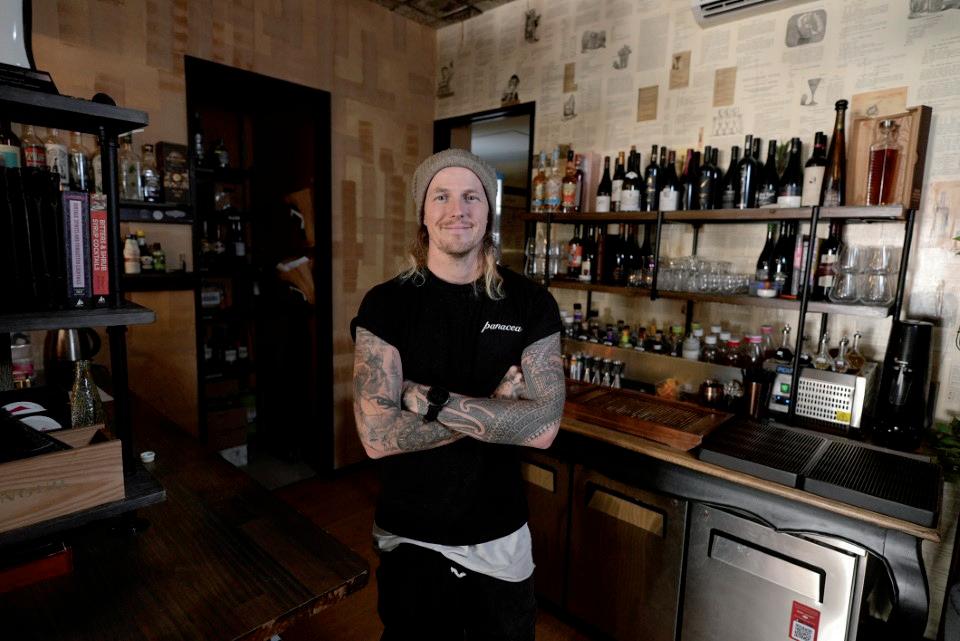




Instagram-worthy dining experiences. User-generated content is a beacon of authenticity in a world of paid advertising and digital gimmicks. Unlike influencer marketing, which often feels orchestrated, user-generated content (UGC) is born from genuine customer experiences.
This authenticity resonates deeply with audiences, as it reflects real moments shared by real people. When harnessed effectively, UGC becomes a low-cost, high-impact strategy that can significantly enhance your brand’s visibility and credibility.
Creating that Instagram moment starts with the food and drinks you serve. Artistic and beautifully presented dishes are what guests love to photograph and share on their socials. But what makes these photos truly stand out is the backdrop – your table setting. A wellthought-out table top, adorned with bespoke crockery, elegant glassware, and stylish table linens, can elevate the visual appeal of the food and drinks, making them even more shareable.
Each element should be meticulously chosen to reflect your brand’s identity and create a cohesive and inviting atmosphere. This way, every photo taken at your venue is instantly distinguishable as yours and you can start to harness the power of UGC.
Diners today are eager to share their experiences online. One of the most effective ways to leverage this trend is through usergenerated content. When guests capture photos of their beautifully set tables, adorned with artistic food and drinks, and share them on social media, they are not just showcasing their meal; they are endorsing your brand to their followers. This organic form of marketing is incredibly powerful, as it comes from a trusted source – your satisfied customers.
To encourage guests to share their dining experiences, focus on creating visually stunning
table settings. Use unique and distinguishable elements that catch the eye and invite photography. Consider incorporating custom-designed plates, elegant glassware, and stylish table linens. The more visually appealing the table setting, the more likely guests are to capture and share their experience online.
Your tableware is an extension of your brand’s identity. When guests dine with you, they engage closely with these items, forging a tactile connection to your brand. By incorporating your logo and design elements into the crockery and glassware, you create a lasting impression that lingers long after the meal is over.
In the world of hospitality, the details make all the difference. By curating distinctive table settings and encouraging guests to share their experiences, you create a dining atmosphere that resonates beyond the meal itself. Each shared photo becomes a testament to your brand’s commitment to quality and creativity, leaving a lasting impression on everyone who dines with you.

Talk to Harrows today about hospitality furniture – beautiful tailored furniture for social interaction.
0800 142 233 | harrows.co.nz


For customers, the dining experience is one of the most important factors when selecting their restaurant.

Despite a strong emphasis on pest control and ensuring no unwanted pests like rats and cockroaches are found on the premises, little is being done to control birds.
When business owners think about pests, birds don’t immediately come to mind. However, their presence can be just as damaging to a business as cockroaches or rats.
Birds can not only be an unpleasant interruption to the dining experience for customers but also pose a health risk to restaurant customers and staff. Birds carry a range of diseases, from salmonella to Cryptococcosis, a potentially fatal infection. Their moulted feathers can cause respiratory problems, and their droppings can cause serious infections.
A move over the last decade to open kitchen areas means that birds now have access to the kitchen, which was previously more restricted. This calls for stricter protocols; staff must know what to do if a bird has entered the kitchen (flying in or, as many pigeons do, walking in) and may have contaminated the ingredients in the kitchen.
Restaurants and cafes with outdoor dining are well aware of the nuisance factor of birds. Still, the staff must also understand that birds can also make customers ill if where they have defecated is not cleaned thoroughly and any food contaminated is immediately thrown out.
The Auckland Council receives an average of 22 yearly complaints about pests in hospitality environments.
Mervyn Chetty, Licencing and Environmental Health Manager at the Auckland Council, said that all food businesses must have measures to manage pests, including regularly checking for signs of them.

“Birds are much easier to spot than some other pests, but you should still keep an eye out for signs such as droppings, feathers and nesting materials,” said Chetty.
Chetty added that removing their food sources was the best way to discourage birds from frequenting your premises.
“Outdoor dining areas should be cleaned
and cleared frequently, used tableware and waste should not be left to build up, and rubbish bins must be kept covered and removed regularly. Cabinet or counter food should be covered or monitored closely so birds cannot access it.”
He suggested that if birds entering the premises have become a frequent problem, owners may want to consider options such as screen doors or plastic flaps. Chetty also said birds should be scared away if they are seen
Customer health and safety are of paramount importance to the Council and are the driving force behind the food verification process. The Council's Food Safety team strives to work collaboratively with food operators to resolve food safety issues.
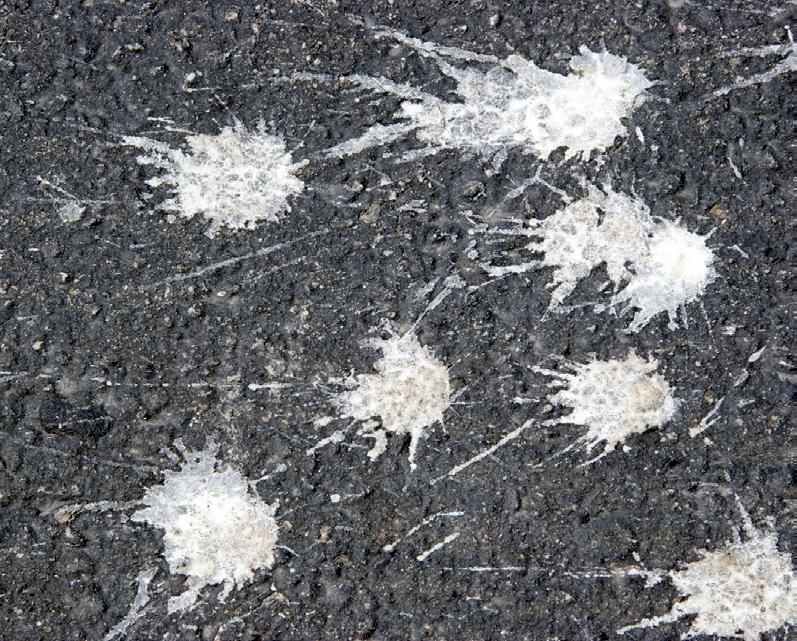
at or near food, and the food should also be checked.
“The affected areas must be cleaned and sanitised, especially where unwrapped food is handled or prepared.”
Today, social media content is important to a hospitality business's image, reputation, and outreach to customers. Younger customers are likelier to snap a pest sighting and upload it to social media than complain to the council.
A recent example is when a pigeon was filmed eating ingredients at an Auckland city Subway restaurant. The footage was viewed over 100,000 times on social media, prompting the restaurant owners to apologise, particularly as the bird was shown being chased away after a customer alerted staff, but the food was not removed.
Although the restaurant had garnered a reputation online, the Auckland Council said it had not been previously notified of its condition.
So, what regulations are in place?
Food and Hygiene Regulations state that every occupier of food premises shall, so far as practicable, keep premises free at all times from birds. Regarding food storage, it also states that food should be kept clean and free from contamination at all times and protected from damp and foul odours against birds.
Council regulators have said that pest control and the ability to manage risks are crucial steps in assessing food businesses during the verification process.
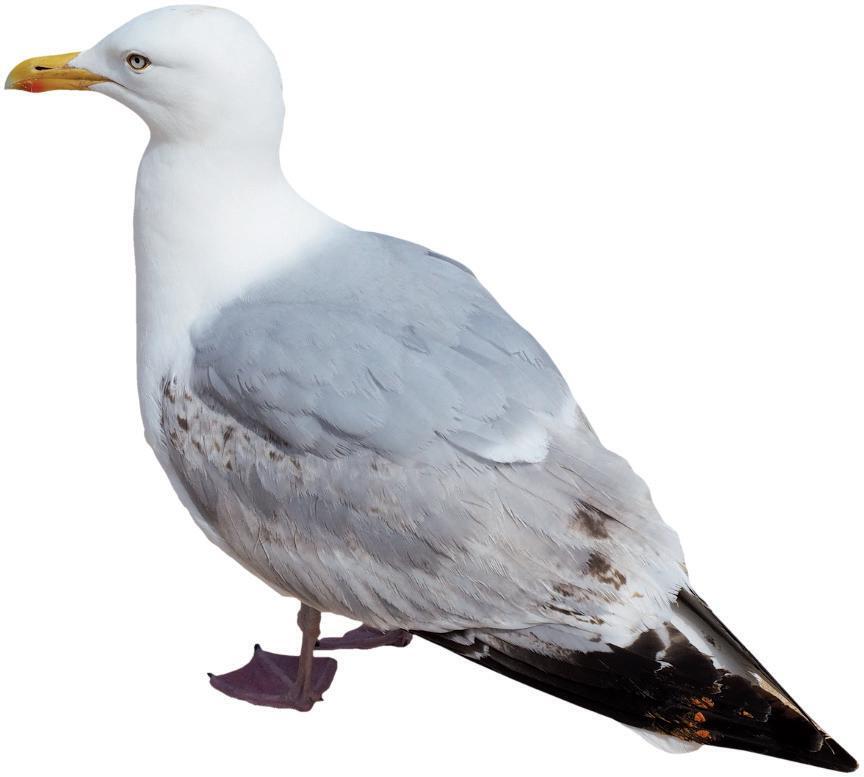
Chetty said that when a food business is identified as having a bird problem, it may continue to operate where it can demonstrate its ability to manage the risks to food safety satisfactorily. This could mean immediately implementing temporary measures while a permanent solution is found.
For Tracey Weston, the Head of Regulatory Compliance at the Christchurch City Council, cooperation is essential from both parties to resolve any issue of this nature.
She said that if the Council is aware of a pest control issue identified during the verification process or in response to a customer complaint, the food safety team will work with an operator to ensure any issues and associated risks are addressed as soon as possible.
Unlike Auckland Council’s eat-safe system, the Christchurch City Council does not implement a grading system, which is not required under the Food Act 2014. However, Weston said the Act requires food to be safe and suitable.
“Customer health and safety are of paramount importance to the Council and are the driving force behind the food verification process. The Council’s Food Safety team strives to work collaboratively with food operators to resolve food safety issues.”
She added that the vast majority of operators were committed to meeting the required standards and prioritising the well-being of their customers. In rare instances where an operator is unwilling or unable to meet their legal obligations, Weston said enforcement action may be taken based on the level of risk and severity. This could range from issuing improvement or direction notices or prosecution.
Similar penalties are in place by the Auckland Council, which said businesses could be fined up to $50,000 for non-compliance with council orders.
“Customer health and safety is why we have a food grading system. Verification of food businesses are carried out to ensure a food business is selling safe and suitable food and that the business is following good food safety processes,” said Chetty.
If the risks presented by birds to a food business are deemed critical, a food safety officer may close the business until it is eliminated. A further consequence is that when a business is shut down, it will receive an E grade.
Ultimately, bird prevention is a critical responsibility in hospitality. The stakes are high, and owners must remain vigilant to protect their customers and their businesses from the risks birds bring.
Remember, everyone has a camera these days, and customers are far more likely to post on social media than to complain to the council.





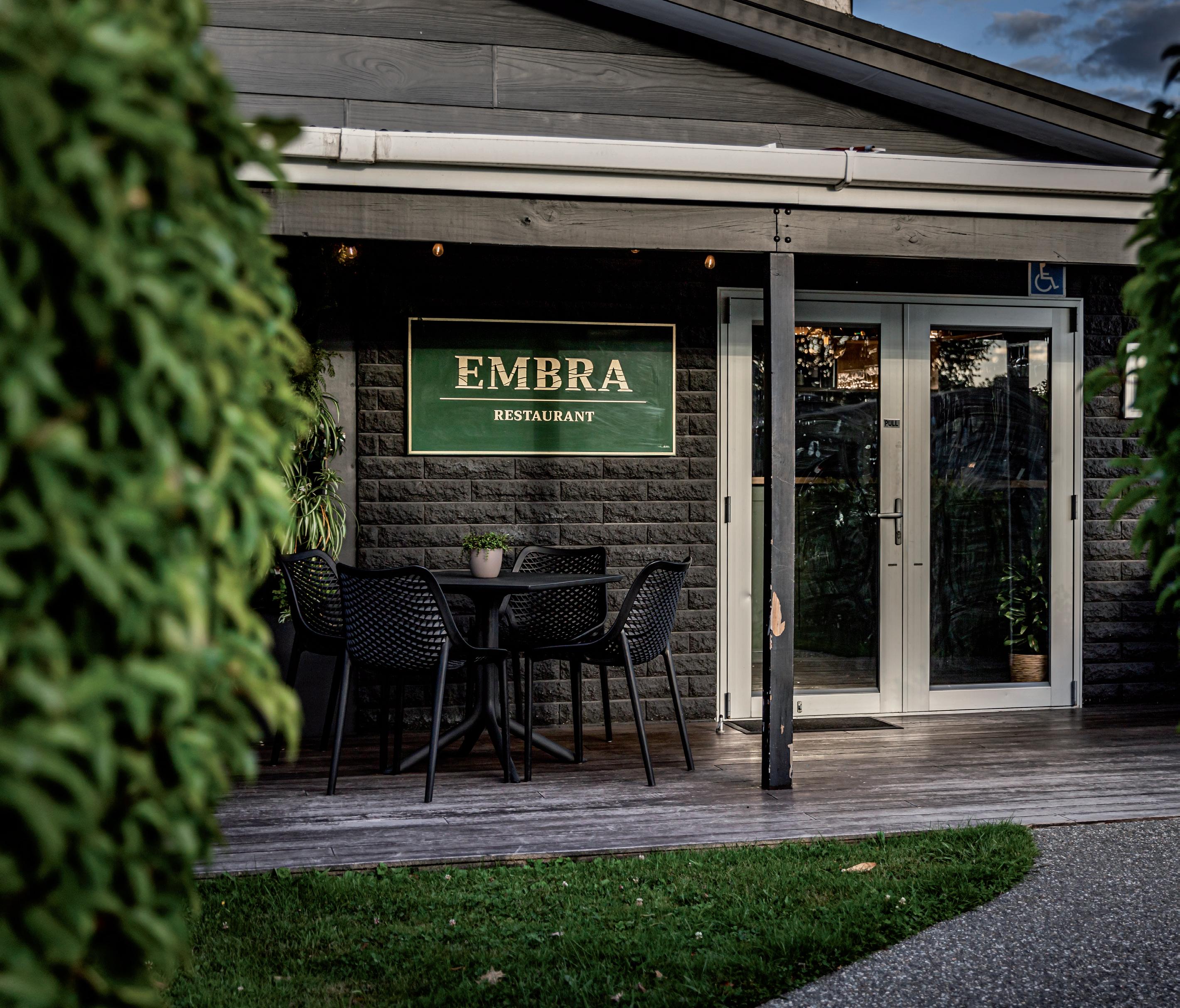
Sustainability has proved to be a guiding light for the small-town hospitality sector, such as Embra, one of Taupo’s hospitality success stories.
Since Embra opened its doors in early 2022, it has become a hub of culinary activity within the local community.
Behind its success has been the husband and wife team of Taupō local Phillip and Latvian-born Nora Blackburne. Influenced by French and British cooking techniques, Embra changes its menu frequently, and guests are invited to enjoy a three or five-course menu in a relaxed, stand-alone townhouse setting. The restaurant’s menu has highlighted some of the outstanding produce available in the region, as well as other fresh produce from around the country.

Embra’s menu and wine list are kept short, and its dining room can only seat up to 30 guests at one time. Phillip Blackume said the main focus has been on quality over quantity,


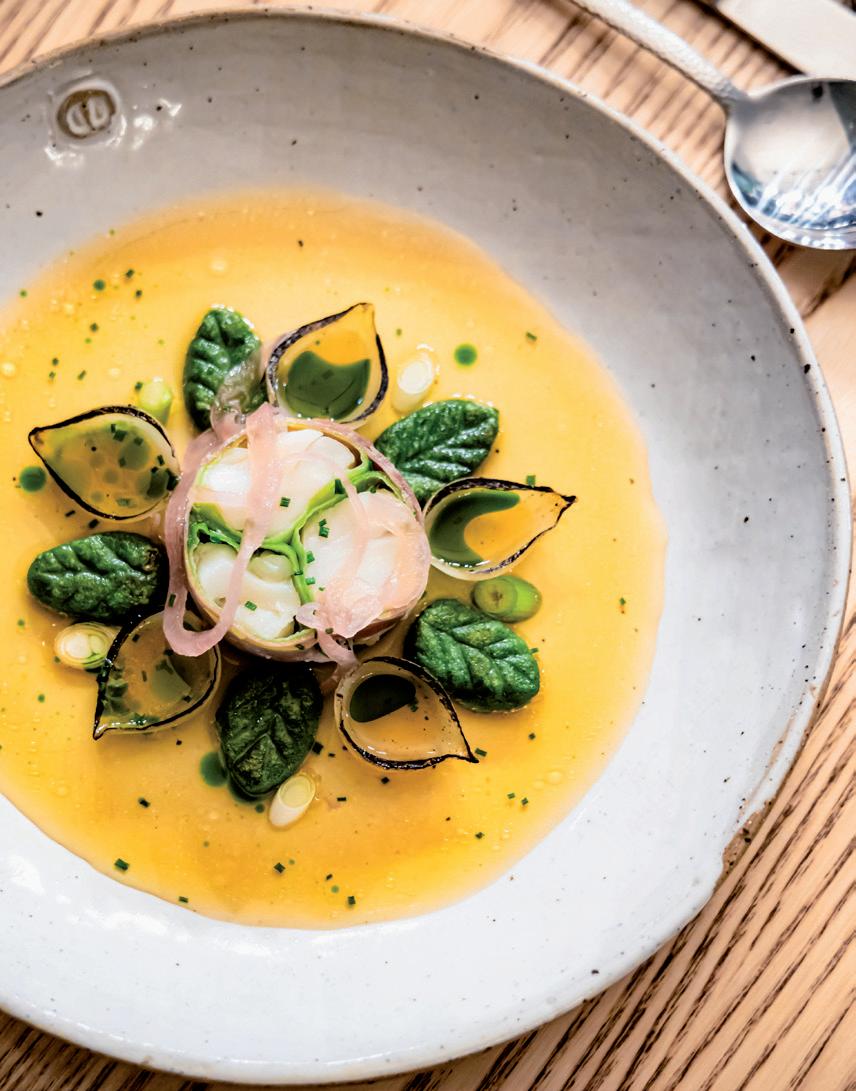

and to put care and focus into every aspect of the dining experience.
“We have really taken the time to hand-pick our suppliers and work primarily with smallscale and artisanal producers. We let the menu flow with the seasons and very much focus on the produce that is available at the given time of the year,” said Phillip Blackume.
Innovation has been crucial for Embra, and as the world changes, so must hospitality. A big part of Embra’s philosophy has been to use sustainable and traceable produce. Since partnering with local business Misfit Garden, Embra has taken on the initiative of using produce unsuited for supermarket shelves.
An example of this has been the introduction of tiny Packham pears, which were a component in a pork dish. Each pear was wrapped in pastry and filled with confit pork, chorizo and parsnip. Blackburne said the dish was received very well by guests, and it was fulfilling to use produce that would have otherwise gone to waste.
“I feel it is equally as important to have a solid base concept to build on. In my view, it is a lot about this balance – innovating, finding new solutions and ways of doing things on the one side and remaining consistent in quality and true to the individual philosophy on the other end of the scale.”
Whilst Taupō is not generally known as a food-producing region, its central location has made it just a stone's throw away from anywhere in the North Island. Blackburne said the Taupō dining scene had become more and more diverse, and that recent events, such as the Treats of Taupō festival, highlighted the best the region had to offer.
“Taupō is a destination and that is part of what we are aiming to be, and we are hoping to add value and diversity to our hospitality scene here.”
Taupō winters have tended to be the slower season of the year for the hospitality sector, with the past few months even slower than expected. Blackburne said the general economic climate had likely been the culprit. As the warmer weather has trickled in, he had noticed an uptick in bookings ahead of what has historically been the busiest time of the year.
One of the latest trends for restaurants in the area according to Blackburne has been for hospitality personalities to collaborate all across the country,some thing he said was a great way to showcase talent and prove how vibrant the hospitality industry scene in New Zealand is.

EMBRA CHEF AND OWNER




As flexible working has become the norm, the hospitality industry has felt the economic impact, particularly in city centres where office workers once filled cafes, restaurants, and bars.

In Wellington, the shift to remote working has been especially pronounced, with civil servants and office workers no longer providing the regular footfall that hospitality businesses depend on for their daily trade. For an industry that thrives on a bustling urban environment, the move to working from home has created significant challenges.
Hospitality businesses have made it clear: the reduction in office workers has led to a downturn in revenues. Where once the daily lunch rush, after-work drinks, and coffee catch-ups kept city-centre cafés and restaurants busy, these same businesses are now seeing reduced activity. The capital city, home to approximately 28,000 full-time equivalent civil servants, has been notably affected, as fewer people in the office means fewer customers filling the seats of local eateries. For many businesses, this decline has been difficult to manage. With fewer customers coming through the door, the ability to generate revenue is impacted. Hospitality venues rely on the daily rhythm of office workers, and when this disappears, the entire ecosystem is disrupted.

The Restaurant Association has welcomed the government’s recent encouragement for civil servants to return to the office more frequently. Civil servants play a key role in city-centre economies, and by bringing them back into the office, the government is setting a vital example for the private sector to follow. In Wellington alone, the 28,000 civil servants make up a significant portion of the city's workforce, and their presence is crucial to the economic health of the city centre. Encouraging this workforce back into offices would not only support hospitality businesses but also encourage corporates to reassess their own flexible working policies.
When government leads by example, it signals to other businesses the importance of maintaining a vibrant central business district (CBD), where both public and private sectors thrive. A return to in-office work from the public sector would help set the tone for the corporate world to follow suit, ensuring that city centres remain active, prosperous places to work, shop, and socialise.
In Auckland, the effects of remote working on the CBD have been stark. Studies revealed that around 30,000 fewer people are travelling into the city centre each day compared to pre-Covid levels. Viv Beck, CEO of Heart of the City, has been lobbying for change, emphasising the need to bring people back to the CBD to support local businesses that are still struggling to recover. The reduced foot traffic has meant that
businesses in hospitality and retail are facing ongoing challenges in maintaining sales and service levels.
Auckland's experience mirrors the situation in Wellington, where the presence of civil servants and office workers is essential to citycentre economies. As Beck has pointed out, the continued absence of workers from city centres is a significant contributor to the struggles faced by local businesses.
While the hospitality industry understands the importance of flexibility, there needs to be a balance. We’re not advocating for an end to flexible working arrangements, but rather a measured approach. Working from home is essential for many, but if it becomes the default option for the majority of people, we risk losing the vibrancy that makes our cities special.
Regular office-based work not only supports local businesses but also keeps city centres alive. The decline in office presence has been cited by many hospitality businesses as a key factor in their struggles. By encouraging more workers back into the office—whether that’s a few days a week or on a more regular basis— we can begin to restore the economic health of these vital urban hubs.
In the end, the goal is to find a balance that allows flexibility for workers while ensuring that city centres—and the businesses that rely on them—can flourish. A thriving hospitality industry is essential to vibrant cities, and bringing workers back into offices is a crucial step in supporting that.



Kiwi coffee brand Zephyr Coffee Co. has partnered with Kakano Youth Arts Collective for their newest artist collaboration, featuring on their coffee bags, in-store point of sale and merchandise.

The Kākano initiative was developed by independent artist Mandy Patmore following a pilot programme established in 2013, recognising the needs of some of West Auckland’s most vulnerable young people, all of whom had struggled with mainstream education.
Since then, it has grown into a hugely successful initiative and has changed the lives of many young people.
Continuing in her role as Creative Director, Patmore has been supported by a team of art tutors and youth support workers, enabling Kākano to run three sessions a week for the rangatahi, working closely with Oranga Tamariki, NZ Police, alternative education providers, youth services and local government.
Under the guidance of these highly experienced tutors, all practising multidisciplinary artists, the rangatahi can develop their art practice, increase their confidence and strengthen their self-worth.
Alongside the studio sessions, Kākano has a strong presence in the wider community, creating murals and artworks for public spaces, allowing the group to develop real, tangible skills that can be applied to multiple pathways in the future.
“We are proud to support this unique and special programme and have been working
with their young artists to create a series of designs to showcase over the next 18 months,” said Patmore.
“Our first feature artist, 19-year-old Georgia has been a member of Kākano for five years, and it has been incredible watching her design develop and evolve. Her interpretation draws from the journey of our coffee and the distinct personality of the Zephyr brand.
Her approach combines a detailed depiction of a native Kōtare bird with an abstract background.”
She said that the background colours had been chosen to reflect the shades of a coffee cherry, and the Kōtare was inspired by the definition of Zephyr as a gentle breeze, capturing a sense of freedom, courage, and adventure.
The new artwork will be visible across all Zephyr partner outlets. A complete list of Zephyr partner cafes can be found on the website at http://www.zephyrcoffee.co.nz/ stockists.

by



Born and raised in Christchurch, Michael Pickering has been working as the head barista at Hill House Cafe in Auckland’s Hillsborough suburb.

Having worked at various cafes of all sizes, his love for coffee dates back to when he was the sole barista at a small cafe. He took ownership of the brand behind the cafe and developed his reputation as a barista.
“At Hill House Cafe, we make all the classic coffee orders, but we make them great,” said Pickering.
“I think a great coffee comes down to taking your time to break down each process, from the shot to the milk, to be consistent and made with love.”
He added that no matter how busy he was or how many things he had to do, he would stop everything else to focus on perfecting it whenever he was dropping a shot or steaming milk.
Pickering’s first coffee of the day is an Americano because it stays hotter for longer. He said he needed this because he usually
tends to forget to drink it.
The second is a quad shot Americano, usually half an hour later, to jump-start the day. However, he would never say no to a cappuccino if he goes out for a Sunday brunch.
For Pickering, the best part of his job, although he knew it sounded cliche, was the people.
“The customers and the conversations I can have with someone or a quick joke can make our days and is what makes it worth it.”
A highlight for Pickering has been his interactions with customers. One regular customer who has stood out was the one who always shared dad jokes when they came in, something that continuously put a smile on his face.
In his free time, Pickering enjoys music and spending time at the beach, especially during the summer. He has also loved experimenting in the kitchen.

Michael Pickering
HEAD BARISTA HILLHOUSE CAFE




As the head baker at Auckland’s Hill House Cafe, Nonjabulo "Jabs" Ndlovu has always been passionate about creating and implementing new recipes in the kitchen.
Ndlovu was born and raised in Ashdown, a small town in Pietermaritzburg, South Africa, where she completed her high school education and continued at The International Hotel School in Durban.
Her journey in the culinary world began in 2013, right after graduation, at Kloof Country Club in Durban, where she worked as a pastry chef for nearly two years. She then secured an international internship in the United States, where she worked as a commis chef for a year.
Due to her additional level-five qualifications in professional cookery, she initially took on roles in the hotline. After completing her training, Ndlovu was offered a permanent position as a demi chef but decided to explore New Zealand and its cuisine.
With the help of a school friend, she secured another internship, which led her to work at The Hermitage Hotel in Mount Cook, South Island.
She said that she had dreamed of working abroad since her teenage years, which drove her to enrol at The International Hotel School. She began at Pepperjack in Beachlands as a Senior CDP, where she impressed her colleagues and was put in charge of the cabinet, lunch, and dinner desserts. She even had a dessert named after her, the Jabs' Malva.
“My eagerness to learn and grow in the hospitality industry led me to accept this opportunity with both hands,” said Ndlovu.
“The most rewarding part of my job is seeing the smiles on customers' faces as they
appreciate my freshly baked goods.”
Baking has been a part of Ndlovu’s life since 2013, when she started her first job. The art of pastries, cakes, and bread and the intricate preparation methods captured her attention.
She has several favourite creations, but her top three include malva pudding, summer tarts, and sourdough focaccia, which has become her latest obsession.
Malva pudding is a South African dessert that reminds her of home since she often baked it with her mother. Sometimes, she adds a twist by incorporating Amarula liqueur, a unique African spirit made from the marula fruit.
At the same time, she has found summer tarts to be quite creative and fun to make, especially with fresh fruit and homemade shortcrust pastry.
“I find the current trends in French pastries and sourdough bread fascinating. Seeing new and improved recipes and techniques excites and inspires me to try new ideas.”
At Hill House Café, Ndlovu has continued to make the iconic Cinnabuns, the café’s most popular baked goods.
“They’re the most delicious, fluffiest, mouthwatering treats ever – that’s a fact.”
Outside of work, Ndlovu enjoys going out for brunch or staying in for a traditional South African braai (BBQ) with her family. Her goal for the near future is to become a partner at Hill House Café and continue elevating it to greater heights.
She advised other upcoming bakers to
stay true to themselves, as the road can be challenging.
“I had to work through many kitchens as a line chef before finding the perfect one for myself. Anything is possible if you believe in yourself. I’m proof of that, a young girl from a small town in South Africa, now head baker at an iconic cafe in Auckland. It is possible.”

HEAD BAKER HILLHOUSE CAFE




The race to harvest New Zealand's fastest-growing vegetable will hit full speed this month, with over one million spears of asparagus being hand-cut daily.
Boyds Asparagus Industries Ltd, based in Cambridge, is a member of the NZ Asparagus Council and produces one third of our national crop. Managing Director Andrew Keaney says freshness is the key to winning over consumers and driving retail sales.
“We pick, pack and dispatch on the same day to ensure peak freshness. We also use precooled, washed and hydro-cooled processing to maintain optimal quality. The most important thing that retailers can do is keep the product fresh by only buying what they can sell in a day,” he says.
“The flavour and texture of asparagus is so different when it’s fresh compared to when it’s three or four days old.”
With over 130 hectares of production, Boyds is a leading grower, packer and marketer of asparagus. The business was established in 1982 and the Waikato’s fertile, well-drained soils are ideal for asparagus cultivation.
“It’s very fast growing. On a warm, hot day it’ll grow up to 17cm. You can literally lie in a field and see it moving. To try and understand how much I’m going to pick the following day, I put a peg in the ground each morning so I can measure the speed at which it’s growing. It all depends on the temperature.”
Thanks to favourable weather conditions, the season started in early September – about 10 days earlier than normal. Supply will run
through until Christmas.
“I love eating asparagus. It’s nutritious, packed with goodness, and incredibly versatile and convenient to cook. Growing asparagus allows me to combine my passion for highquality food with my love for working in the fields.”
Keaney says the biggest industry challenge is driven primarily by cost inflation.
“We’ve focused on increasing efficiency by incorporating technology and automation where possible. However, the cost of harvesting remains our most significant hurdle. Each asparagus spear is still harvested by hand, as no automation technology exists to handle this task efficiently.”
While robots are currently used in limited prototypes in the UK, they are still far from commercialisation. Even when this milestone is reached, Keaney says robots will not provide a complete solution and human labour will remain necessary.
“Asparagus doesn’t grow in a straight line. The crown beneath the ground shoots up asparagus spears in different directions. A robot has to position itself over each crown and assess what spears are ready to pick, then constantly reposition itself. There might be one spear that’s not quite ready. You have to be able to see what the best angle is to cut each spear without damaging the one growing beside it which is too hard for a robot to do.”
Boyds will employ around 200 people this month to ensure the crop is harvested in time.
“During peak season, we pick over one million spears daily, with our harvest crews covering more than 1,000 kilometres of fields each day. Given asparagus’s rapid growth, it’s crucial to harvest daily to prevent the spears from becoming too mature and going to seed.”
Once in store, Keaney says asparagus should ideally be kept refrigerated. “But ambient temperature is okay as long at the product is fresh that day.”
Spears should be firm to touch (not limp) and the butt (where it has been cut) shouldn’t be dry or caving in.


